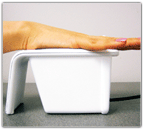 Biometric technology expedites lunch lines
Biometric technology expedites lunch lines
The Pinellas County School Board District in Clearwater, Fla. has paired up with technology provider Fujitsu Frontech North America to provide a reliable and secure method of handling school food service program transactions.
With more than 102,000 students, the district is the seventh largest in the state and the 24th largest in the nation. Efficiently serving this large population has, at times, proven challenging for the district, particularly in the school cafeteria snack and lunch lines.
Officials have tried everything from swipe cards to PINs, none of which seemed to help. The district even tested a fingerprint scanning system but it proved unreliable. “Students would place their finger on the scanner and leave behind oil, dirt, and residues. This would cause the system to malfunction or freeze up delaying the cafeteria lunch lines,” said Art Dunham, director of Food Service Department at Pinellas County Schools.
Then the district learned about vascular biometrics. Unlike other biometrics, vascular devices don’t require contact with the student’s skin so they are hygienic, non-intrusive and unrestricted by external factors such as skin types and conditions. They identified Fujitsu Frontech and its PalmSecure biometric sensor.
PalmSecure uses near-infrared light to capture and store a student’s palm vein pattern, generating a unique biometric template that is matched against pre-registered user palm vein patterns. This makes forgery virtually impossible.
As part of the project Fujitsu partnered with MCS Software, an integrator for school food service environments. Pairing PalmSecure with MCS’s Newton point-of-sale system resulted in a fully integrated solution for managing snacks and meal plans.
The system increases security without a need for student PINs or fingerprint scanners. This minimizes transaction times, which keeps cafeteria lunch lines moving at a steady pace. “The process is relatively simple,” explains Dunham, “and registration takes no longer than 20 seconds.”
To register, a staff member first searches for the student’s name in the district’s centralized database. MCS’s point-of-sale software then displays the photo, in addition to class information, so that the student can be positively identified.
The student places a hand on the scanner for initial palm enrollment. A series of scans are performed to generate a unique and accurate biometric template. The template is a numeric representation of selected points from the vascular pattern. It makes it possible to compare future scans for authentication without storing an actual image of the palm vein pattern. After enrollment, the template is encrypted and stored on the district’s database.
Once they have enrolled, students simply walk up to the cafeteria register with their food and place their hand on the scanner. In a matter of seconds the system pulls up their information and deducts the necessary charges required to complete the transaction. The use of biometric scanning also remedies conventional problems associated with students forgetting or sharing PINs and swipe cards.
Parents can go online to add funds in their child’s meal account, set charge limits, see what their child purchased for lunch, monitor diets and view nutritional facts. “If a student is eating pizza every day the system will let them know about it,” Dunham says.
Additional features include medical and allergy alert messages for individual students. In the event a child unknowingly purchases a meal that may have adverse effects, or worse, causing a potentially life-threatening allergic reaction, the system can provide an alert.
With previous systems there had been long waits that affected students. “It’s hard for students to focus and learn if they go the whole day hungry. In the past, due to long lunch lines, we found that students would just simply skip lunch,” Dunham says. “This remedies that problem and ensures students have the adequate time to eat their lunch, so that they can make it through the rest of their day comfortably.”
Enrollment in and use of the biometric system is completely voluntary. Parents and students who opt out have the choice of using the traditional PIN number, with elementary students alternatively using a series of unique images to securely complete food service transactions. “We do have parents who prefer that their children not participate in the program and that’s fine. We offer a different option so that everyone–both students and parents–remain happy,” Dunham explains.
Currently only the high schools and middle schools are participating in the system. Still, explains Dunham, some 46,000 students have been enrolled. The system will be expanded to the elementary schools later in the school year.
The district has ordered 300 palm scanners totaling around $120,000. Pinellas County also has plans to expand the PalmSecure system to support other school services and events including bus rides, field trips, attendance, yearbook sales and event ticketing.




